|
F.N. Kivette landed once at Tucson, Monday, August 19, 1929. He flew an unidentified Boeing F2B. Based at San Diego, CA aboard the U.S.S. Saratoga, he arrived amidst nineteen other naval aviators, each signed into the Register on the middle third of page 112. Other than the first six who signed their own names, the rest were entered by an unknown hand all at once. Please direct your browser to the link and review page 112. There you'll see that signers Chourre through Wick comprise the group of twenty. They all remained overnight at Tucson, departing the morning of the 20th for El Paso, TX.
What were twenty Navy pilots doing at Tucson all at once? They were on a grand cross-country flight headed from San Diego to Cleveland, OH and back to participate in the National Air Races (NAR) held August 24th-September 2nd at Cleveland that year. Lt. Cdr. Homer Wick was commanding officer of Squadron No. 1 based on the Saratoga.
Wick brought his entire squadron through Tucson on behalf of the NAR. During the 1920s and 1930s, the Navy ordered numerous activities by its personnel, ships and airplanes to build confidence in the naval force among the U.S. citizenry, to provide real-life training for personnel, as well as to encourage recruitment.
Kivette's job was to participate with the aerobatic team named the "Nine High Hats." Below, Kivette is circled and shown with the rest of his section (the officers immediately in front, Leslie Gehres, and to his right, Frank O'Beirne) and the entire 9-man team just three days before he landed at Tucson. Please direct your browser to Wick's page to see a tabulation and identification of all the men in his squadron.
The "Nine High Hats," August 16, 1929 (Source: NHH via Woodling)
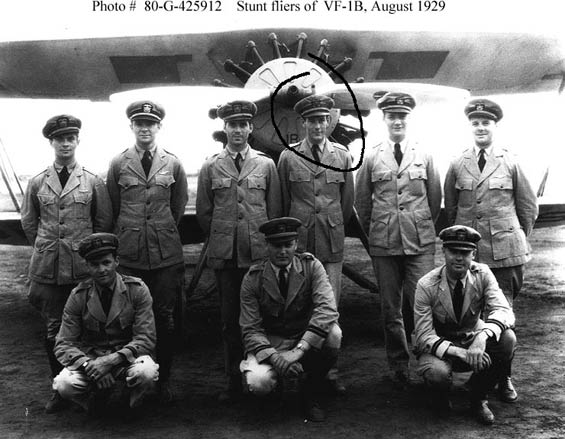 |
Frederick N. Kivette, 1925 (Source: Woodling)
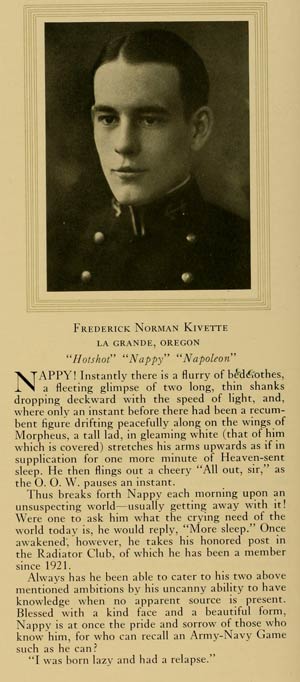 |
Kivette graduated from the U.S. Naval Academy in 1925. Photograph and information, right, is from the Academy yearbook. He went to flight school and received his Naval Aviator rating in 1928. Shortly after, he posed for the photograph above and participated in the NAR.
He was stationed at San Diego from 1929 through 1932. In 1933 he was assigned to the Akron dirigible. In 1934 he was assigned to the Macon dirigible and from 1935-36 was assigned to VS-5B. If you can help identify his duties as a member of VS-5B, please let me KNOW.
Early in 1935, Kivette was based aboard the dirigible U.S.S. Macon. As he did on the Akron, on the Macon, Kivette flew the small Curtiss F9C-2 Sparrowhawk aircraft which hooked onto the Macon via a trapeze device. The Macon crashed at night on February 12, 1935. A list of the 76 Macon crew is at the link. Later in 1935 Kivette received commendation for his role in the minimization of the U.S.S. Macon disaster. The Seattle (WA) Daily Times of August 29, 1935 reported, "Lieutenant Frederick N. Kivette, Lieutenant Earl Van Swearingen and Chief Boatswains Mate Robert J. Davis were commended by Admiral Butler, and his action was approved by the Secretary of the Navy." I was unable to determine what commendable action was taken by Kivette and the others, but it appeared from the article that formal commendations were made to most of the Macon crew, including the two who died.
Seattle (WA) Daily Times, February 11, 1938 (Source: Woodling)
 |
In 1937 he was assigned to Fighting Squadron 4, "The Red Rippers," aboard the U.S.S. Ranger.
From 1938-39, he was assigned to the Naval Academy, Training Squadron 8 (see the article, left).
In 1940, he went to Patrol Squadron 44. On July 7, 1941, he commanded the seaplane tender, U.S.S. Williamson assigned to the Aleutians. As the Western Tender of the Aleutian Reconnaissance Group, the Williamson's orders read, in part, "WESTERN TENDER - Load advanced base personnel and equipment. Depart KODIAK for DUTCH HARBOR fifteen July. Operate in accordance tentative itinerary, Annex Affirm, being prepared to tend planes as indicated therein. On completion reconnaissance remain KODIAK area, operate as directed."
At the time of the Battle of Midway in June, 1942, then Lt. Cdr. Kivette, still in Alaska, was in the Order of Battle aboard the Williamson, as part of Task Group 8.1, Air Search Group, under the overall command of his High Hats team mate (above) Capt. L.E. Gehres.
Below, an earlier photograph of the Sparrowhawk team taken at Lakehurst, NJ ca. July, 1933. This crew were then attached to the U.S.S. Akron, which itself crashed into the Atlantic Ocean off New Jersey on April 4, 1933, losing 73 of its crew of 76. The only good news about this tragedy is that the Macon then took aboard life jacket packs for all crew members. The Akron had none. The losses of Akron and Macon ended the Navy's rigid airship program.
Sparrowhawk Team, 1933 (Source: Web)
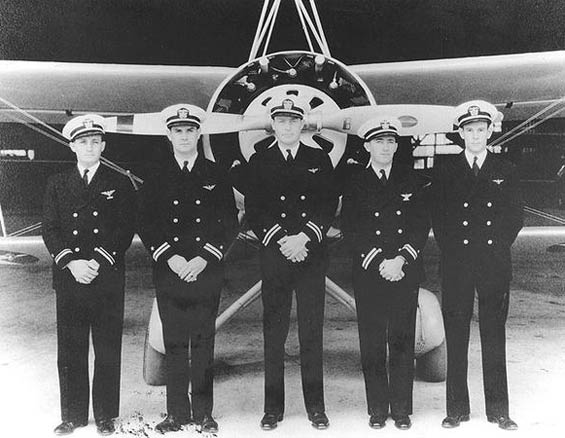 |
Kivette in Sparrowhawk, October 12, 1934 (Source:
NHH via Web)
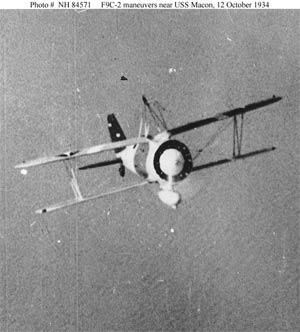 |
The people above are identified as (L-R) Robert W. Lawson, Harold B. Miller, Frederick M. Trapnell, Howard L. Young and Kivette with his hands in contrary position. They are standing in front of a Curtiss F9C-2 Sparrowhawk. Note the hook apparatus projecting from the top. See photographs, a video link and more details about these airplanes, pilots and hookups at Register pilot Frederick Trapnell's link.
Notably, according to this REFERENCE, page 87, on July 19, 1934, Kivette and Miller flew Sparrowhawks without their wheel landing gear. They dropped from the trapeze of the Macon on a scouting mission over the Pacific and returned to the trapeze. Because of the improved performance of the aircraft on this first flight without landing gear, it became standard operating procedure to fly Macon planes from the trapeze in this configuration.
Photograph, left, shows the Sparrowhawk seemingly without conventional gear. The photo caption reads in part, "Maneuvers near USS Macon (ZRS-5), while being filmed by Fox 'Movietone News' cameras on 12 October 1934.
The plane's pilot was Lieutenant (Junior Grade) Frederick N. Kivette, USN...." Note, again, the trapeze hook on top of the airplane. The New York Times of August 25, 1934 reported Kivette's promotion from lieutenant (jg) to lieutenant, so he was a fresh lieutenant when this film was shot. Other photographs of the Macon, with Kivette flying a Sparrowhawk in various positions around and below her, are online. Google "Frederick Kivette" +Navy.
The New York Times, January 25, 1947 (Source: NYT)
 |
As mentioned, near the outset of WWII, then Lt. Commander Kivette commanded the destroyer U.S.S. Williamson. I have little information about Kivette's service during WWII. If you can help, please let me KNOW.
After WWII he was involved with the atomic bomb tests at Bikini Atoll, as alluded to in the article, right, from The New York Times of January 25, 1947. This article announces his post-war assignment as commander of the Naval Air Station (NAS) at Floyd Bennett Field, NY.
A group of articles appearing in The New York Times during 1947 described Kivette's activities at the NAS. On June 23rd ("125 Navy Planes Fly Over City Tomorrow") was described an airshow put on by the NAS. It was described as, "the greatest air show in the history of the city." It was flown by reservists based at the NAS and involved airplanes as well as two blimps from NAS Lakehurst, NJ. Kivette invited the public to visit the NAS from noon to 4:30PM on the 24th, where the exhibition would include, "a mock attack on the field by massed squadrons."
The New York Times, May 22, 1948 (Source: NYT)
 |
Two articles in September announced the formation and commissioning of Naval Reserve Aviation Unit 3-2. The Unit's duties included, "transportation of personnel, supplies, photographers, etc. Instrument training also will be conducted by this unit."
Commercial air traffic in the New York City area was increasing post-war. Idlewild International (now Kennedy) was newly built, and after July 1, 1948 it was to begin acceptance of traffic from foreign carriers. Planners saw conflicts with the other major New York Metropolitan area hubs, including NAS Floyd Bennett Field. The article, right, is a sample of some of the dialog of the time between the CAA, Port of New York Authority and the NAS. Kivette is cited near the bottom of the article.
Soon, after about 18 months on the job, Kivette was transferred from Floyd Bennett to NAS Glenview, IL. The New York Times of July 31, 1948, below, announced the move.
The New York Times, July 31, 1948 (Source: NYT)
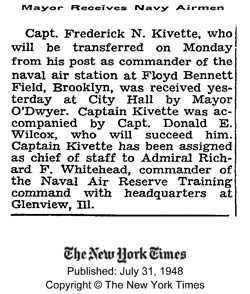
|
By the beginning of 1957, Kivette was a Rear Admiral and Acting Chief of Naval Operations for Air. He appeared in the Times of March 16th gathered among other dignitaries to welcome the blimp ZPG-2 at Key West, FL. The unusual nature of its flight, 264 hours and 12 minutes in the air, was the longest flight by a Navy blimp to-date. He told the crowd assembled that the voyage had not been conceived as a "stunt flight, a flight to make a record," but that it was a study to evaluate prolonged operations of airships for anti-submarine and airborne early warning radar. The ZPG-2 had covered 9,448 statute miles. It had roamed eastward across the Atlantic off the coast of Portugal, down the coast of Africa, then westward to the West Indies and Florida.
The newspapers of the mid-late 1950s were alive with Cold War saber rattling regarding U.S. Navy forces on Formosa vs. the Chinese Communists on mainland China just a few miles away. One source quotes Kivette as saying in 1958, "We always tie up our carriers with the bows seaward. With our catapults, it is possible to launch a strike even while the carrier is in drydock." Article, below, from The New York Times of August 22, 1959 is just one example of many.
The New York Times, August 22, 1959
(Source: NYT)
 |
Kivette was awarded the Navy Distinguished Service Medal in 1961 for his actions during the Cold War as Commander 7th Fleet from August, 1958 to March, 1960, and as Commander Western Sea Frontier/Commander Pacific Reserve Fleet from March, 1960 to September, 1961.
His citation for the medal reads in part, "Vice Admiral Kivette, as Commander SEVENTH Fleet, maintained his forces in round-the-clock readiness and poised for any action the international situation might dictate. Through his broad vision and skillful interpretation of world affairs, ships and men were often strategically located in anticipation of events, thereby averting explosive situations. As Commander Western Sear Frontier/Commander Pacific Reserve Fleet, Vice Admiral Kivette consistently displayed marked professional skill in improving procedures and facilities for logistic support of Fleet units in planning the maritime control and operation of shipping from the west coast of the United States."
Kivette retried as a Vice Admiral. He was born in July 7, 1902. He retired October 1, 1961. He died May 17, 1975 at age 72. His obituary from The New York Times, May 21, 1975, below, briefly highlights his Navy career.
F.N. Kivette Obituary, The New York TImes, May 21, 1975 (Source: NYT)
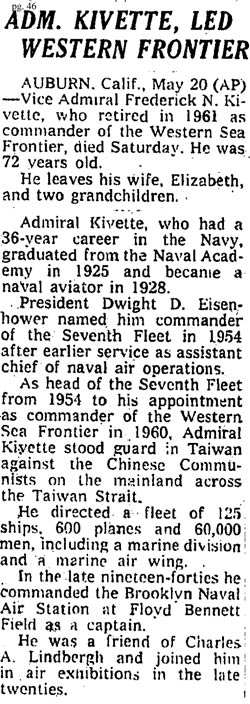 |
Kivette had a son, F.N. Kivette, Jr. born November 18, 1928 and died January 30, 1964. According to Kivette's granddaughter, F.N. Kivette, Jr. was also a U.S. Navy pilot and later flew with American Airlines. The family has no record of either of their pilot log books.
---o0o---
THIS PAGE UPLOADED: 02/10/12 REVISED: 10/16/12
|











